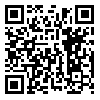دوره 7، شماره 1 - ( 1-1398 )
جلد 7 شماره 1 صفحات 20-15 |
برگشت به فهرست نسخه ها
Download citation:
BibTeX | RIS | EndNote | Medlars | ProCite | Reference Manager | RefWorks
Send citation to:



BibTeX | RIS | EndNote | Medlars | ProCite | Reference Manager | RefWorks
Send citation to:
Saidi H, Dashti A, Asna Aashari M, Gholami Gharab S, Rezai M, Nasirizadeh M. Predictive power of neuron specific enolase for traumatic brain injury in
patients with head trauma. J Surg Trauma 2019; 7 (1) :15-20
URL: http://jsurgery.bums.ac.ir/article-1-136-fa.html
URL: http://jsurgery.bums.ac.ir/article-1-136-fa.html
Predictive power of neuron specific enolase for traumatic brain injury in
patients with head trauma. نشریه جراحی و تروما. 1398; 7 (1) :15-20
چکیده: (4804 مشاهده)
- Introduction: The presence of a predictor for traumatic brain injury (TBI) in patients with head trauma could play a crucialrole in the identification of patients at higher risk of brain injury. The use of serum biomarkers like enolase to predict TBI in patients with head trauma is under investigation. Regarding this, the aim of the present study was to explore theassociation of neuron specific enolase (NSE) with TBI in patients with head trauma.
- Methods: This observational study was conducted on patients with isolated blunt head trauma. A total of 168 subjects were enrolled in the study, 84 cases of whom had isolated blunt head trauma, and 84 individuals had no head trauma (i.e., control group). The serum concentration of NSE in all included subjects was measured within the first 6 h. All patients underwent brain computed tomography (CT) scan. Statistical analysis was carried out using SPSS software, version 19.0. Independent t-test, one way ANOVA, and Chi-square test were used for statistical analysis. The receiver operating characteristic curve was plotted, and cut-off values of serum NSE were calculated to determine the sensitivity and specificity of this biomarker in the prediction of intracranial injuries.
- Results: The mean serum NSE concentrations for patients with head trauma and controls were 23.14±22.63 (95% CI:18.77-28.39) and 7.00±4.42 ng/ml (95% CI: 3.67-10.33), respectively, which were not significantly different (P=0.049). Furthermore, the serum NSE level was significantly higher in the group with severe trauma, compared with that in the group with mild trauma (P=0.023). According to our findings, the NSE of ≤ 15.5 ng/ml can rule out the likelihood of brain injury associated with head trauma with a sensitivity of 100% and a specificity of 88%.
- Conclusions: The NSE can be helpful to predict severe brain injury in patients with head trauma where CT scan or other diagnostic tools are not available. According to our results, clinicians can rule out the possibility of a severe head injury after head trauma when having a case with a serum NSE level of ≤ 15.5 ng/ml.
نوع مطالعه: پژوهشي |
موضوع مقاله:
عمومى
دریافت: 1396/9/30 | پذیرش: 1398/2/16 | انتشار الکترونیک پیش از انتشار نهایی: 1398/3/22 | انتشار: 1398/3/22
دریافت: 1396/9/30 | پذیرش: 1398/2/16 | انتشار الکترونیک پیش از انتشار نهایی: 1398/3/22 | انتشار: 1398/3/22
| بازنشر اطلاعات | |
 |
این مقاله تحت شرایط Creative Commons Attribution-NonCommercial 4.0 International License قابل بازنشر است. |




